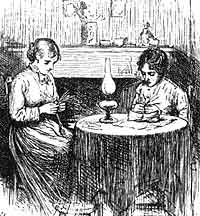 |
 |
 |
 |
 |
 |
 |
 |
 |
 |
 |
 |
 |
 |
 |
 |
 |
 |
 |
 |
 |
 |
Willen Employment
|
 |
 |
 |
 |
 |
 |
 |
 |
 |
 |
 |
 |
Straw hat making in Victorian Willen
|
 |
 |
 |
 |
 |
 |
 |
 |
 |
 |
 |
 |
 |
 |
 |
 |
 |
Whereas in Buckinghamshire the commonest homecraft was lacemaking, in Bedfordshire it was straw hatmaking. (Luton Town Football Club is known as the 'hatters'.) Straw hat making is a very ancient craft; ancient Egyptians and Chinese wore them for working in the fields. In the 19th century, straw hats were worn by men and women, and all classes of people. |
 |
 |
 |
 |
To make a straw hat, special straight straw had to be selected, trimmed and bundled. The straws were then plaited into long ribbons, which could be in a variety of patterns. In Willen in 1881 only one woman was a strawplaiter, that was Mary Chance, the wife of Charles Chance the shepherd, who lived in what is now Grebe Cottage. She was born in Salford, Bedfordshire. Like lacemaking, women learnt the craft when very young at their mother's knee. (Interestingly, when the present owners of Grebe cottage did some work in the loft, they found a bundle of very old straight straws which may have belonged to Mary Chance.)
|
 |
 |
 |
 |
The long plaited ribbons produced were collected by agents who then passed them on to hat makers, who sewed the plaits together edge to edge to make the hats. Hats were pressed to shape, and could be decorated with ribbons, flowers or covered in fabric to make a wide variety of styles. In Willen, Frances Goodman, b 1843, a sister of Alfred and William Goodman, was a hat maker. |
 |
 |







